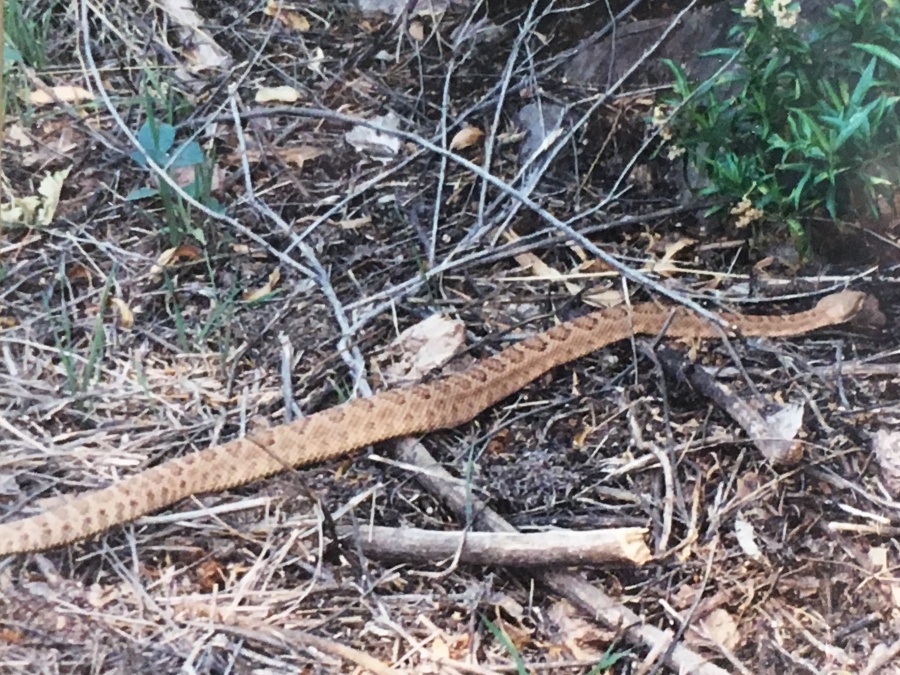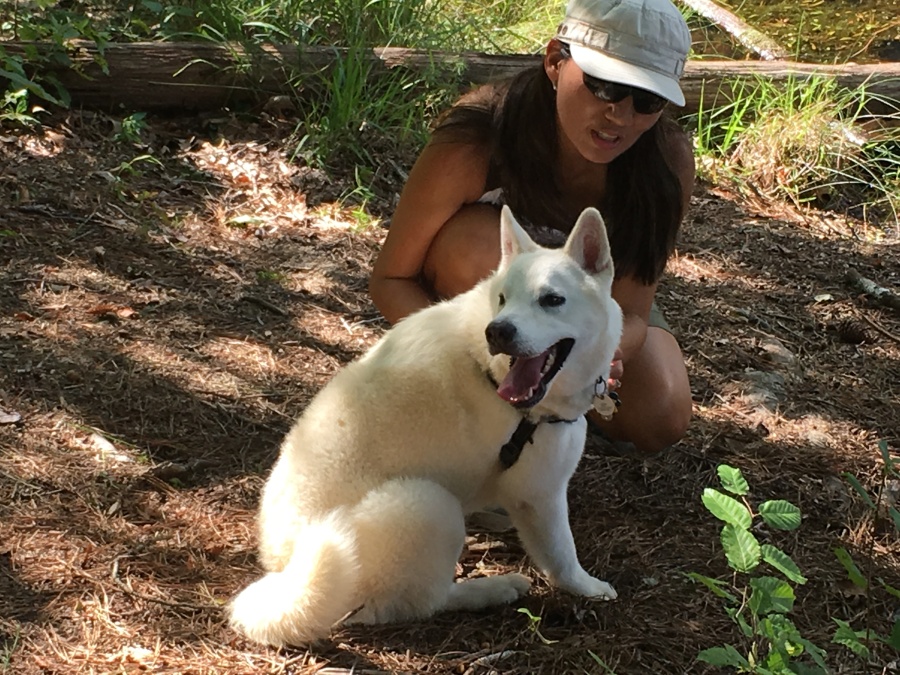Snakes, Snake Safety, What You Should and Shouldn’t Be Worrying About
Fall might seem like a strange time to be talking about snakes. However, just this past weekend we saw this on the trail during a routine walk at Forest Ridge Nature Park just a few miles from our home.

In fact, Brian nearly stepped on it. Sylvia and Fitz Roy walked right by without even seeing it, probably within striking distance.
The snake in question is an eastern black rat, not venomous…but still an aggressive species of snake that doesn’t take well to being stepped on and will bite if threatened. And this one was easily three to four feet long.
This is not the only snake encounter we’ve had in our travels, not the only one we’ve had close to home. We’ve wanted to do a post about snakes and snakebite safety for some time now, so site editor Brian figured this is the time.
We put to the readers a question…what place in the United States do you THINK leads the nation in poisonous snake bites? Somewhere out west you might think? Somewhere in the desert? Perhaps in the mangrove swamps of Florida or the cypress bogs of South Georgia? Death Valley? The Big Bend of Texas?

Nope. Most sources now cite North Carolina as leading the nation in venomous snakebites on human victims. And our own Wake County, NC, is number one in the state.
If you think Brian and Sylvia live in the swamp, guess again. While there are many remote areas in North Carolina both in the eastern and western ends of the state, Wake County is not one. It is the second most populated county in the state, home to over a million people.
The reason that it is the nation’s snakebite capital obviously has nothing to do with its remoteness; in fact it’s the opposite. Wake County’s fast growth and population density are what makes it such a hot spot for human/snake interactions. The number two county for snakebites is Mecklenburg County – the states MOST populous.
It’s hard to get an actual count of how many people are bitten by poisonous snakes in Wake County and how that number has changed over the years, because there is no online database of snake bite metrics anywhere. According to the latest numbers Brian was able to find though, there is very little doubt that a large number of snake bites do occur in North Carolina, and that a disproportionately large number of these come from Wake County.
The principal culprit behind the bites is the copperhead. While rattlesnakes and cottonmouths also occur naturally in the state, neither is common in Wake County. About 90% all the reported bites are from copperheads.

This in itself is odd, because the copperhead is generally described as one of the least aggressive species of poisonous snakes. The reason for all the bites is probably because the copperhead relies on stealth rather that open displays of aggression to avoid predators…it freezes when approached, unlike the rattlesnake and cottonmouth, which coil and demonstrate aggressively. When a copperhead bites it is usually because the snake either accidentally stepped on, or deliberately provoked.
Some facts:
- North Carolina on average records the most reported copperhead bites of any state by far. One study found that the state had 50% more reported bites on average than the next state on the list, which is West Virginia.
- In 2009, North Carolina led the nation with 228 venomous snake bites. About one in five of these was from Wake County.
- From March to October 2017 – the months when snakes are most active – Wake County registered 82 venomous snake bites.
- WakeMed, a local medical center system, reported that they see upwards of 100 bites a year from Wake County annually. In 2018 they handled 130.
- In August, the Wall Street Journal reported that snakebites cases were up 10% over the same period a year previous in North Carolina and Georgia.
- In just the month of May of this year, 92 people were bitten by Copperheads in North Carolina. Over the previous five years, the average was 85 per year.
- Snake bites in the months of January through April were also up.
Note that Wake County also has a very high incidence of dogs being bitten by snakes as well. Dogs are seriously more at risk than human both to be bitten, and to suffer serious injury or fatality as a result of being bitten. We know of two friends who have had dogs bitten by copperheads in the last few years, both right in their own backyards. Both survived and are doing well. We are always very vigilant for snakes whenever we are out with Fitzroy.

There are many theories as to why so many snakebites happen here. Increasingly short winters, longer and warmer summers, increased rainfall and even unusually large infestations of cicadas (a major food supply for young copperheads) are all postulated to be causes.
The most likely reason, however, is the obvious one. Wake county is one of the fastest growing in the nation, and since copperheads have always lived here, it’s no surprise the number of bites has increased as well. There are simply many more people moving into copperhead territory, and greatly increased development has increased the opportunities for human/snake interaction.

Whatever the actual number, one thing should be clear…you should not be overly concerned about being bitten by any snake in the United States. Snakebites here are rare and even when they do occur are seldom fatal. Some numbers:
- 7000 to 800 people are bitten annually by venomous snakes in the United States…of those about five die. That’s about a one in fifty million statistical probability.
- Lightning strikes kill more people on average. So do bee stings and dog attacks.
- Almost all fatalities from snakebites in the United States involve the diamondback rattlesnake (also found in NC, but much rarer and the copperhead.)
- Snakes in the US are far less venomous and aggressive than species in tropical areas, and access to treatment is generally far better.
To sum up, almost all snake bites can be prevented through simple diligence and caution. And even those snake bites that do occur are seldom fatal.
To prevent Snake Bites
- Remember that few snakes, and certainly NO snake found in the US, comes looking for trouble
- Don’t engage in acts of serpentine Le Stupid. For example:
- It is almost embarrassing to have to say this but…don’t deliberately provoke venomous snakes under any circumstances
- If you can’t tell a venomous snake from a non-venomous one, better give them all a wide berth
- The most common circumstance for a reptile attack according to some studies is that the animal was provoked (as much as 70% of bites)
- Don’t drink and snake – Arizona authorities reported that the most common snake bite victims are males under the age of 25 who have been drinking
- If you find a venomous snake in your house, garage or yard, don’t try to remove it. Call the authorities…or let it slither away, most likely you won’t see it again
- Killing a venomous snake is itself very dangerous and should only be attempted by a trained professional
- A wounded snake is EXTREMELY DANGEROUS, and that’s what you have when a kill attempt is botched
- Even a dead snake can administer a serious dose of venom
- The second most common circumstance of snake bites is simple mischance…IE, accidentally stepping on or disturbing one. You can reduce the chance of an accidental bite by:
- Wearing sturdy shoes and protective clothing when walking or working in the outdoors
- Exercise caution when clearing brush and debris
- Exercise caution at night and at dusk when snakes are most likely to be active, and least likely to be noticed (and bring a flashlight)
- When hiking, SOTTS (Stay On The Trail, Stupid!)
- Be wary of placing your hands in holes, around corners and underneath objects you can’t see
- Be wary in general on rock ledges where snakes like to sun, and brushy areas where they like to hide
- In arid areas especially, snakes tend to be found near water
- If you come upon a snake and it is coiled, cornered, looks belligerent or agitated…BACK OFF
- HEED WARNINGS such as coiling, rattling, tail shaking, a raised head…
- Note that not all snakes will warn you before biting; copperheads are notorious for not giving any warning
- If you see one snake, make sure there isn’t another around
- Most snakes cannot strike more than half the length of their bodies, if that far, and no venomous snake in the US is more than seven feet long. So simply staying back a few feet from a snake you can see will keep you entirely safe
- Dog owners beware…leash pets and don’t let dogs play freely around brush piles, rocks, debris etc. They are especially prone to being bitten, often right in the face

What to do if you ARE bitten by a venomous snake:
- Stay calm
- Seek medical attention immediately; if you have a phone, call 911
- Get to a hospital or medical center promptly
- Note the type of snake if you can; use that mobile phone to take a picture if possible (but don’t risk another bite doing so)
- Take off rings, watches, jewelry (IE prepare for swelling)
- If you can’t immediately get to a hospital, lie down with the bite below the level of the heart and don’t waste time with any of those home remedies you might have heard, almost all are worthless (see below)
What NOT to do:
- DON’T Panic
- DON’T Run or start hurrying
- DON’T Cut open the wound
- DON’T Try to suck poison from the wound
- DON’T Apply anything other than soap, water and a dry compress to the bite
- DON’T Apply ice
- DON’T Drink alcohol or caffeinated beverages
- DON’T Apply a tourniquet
- In general, don’t engage in any home/popular culture snake bite remedies
- The only reasonable way to treat a snakebite is with antivenom, and the only place to get that is a hospital; anything else you do is wasting time, effort and likely making the problem worse
Note that a large proportion of venomous snakes bites result in only a fraction of the normal dose of venom, or none at all, being administered (so called ‘dry’ bites.)
Hikers should keep in mind as always that while the risks of snake bite is something to watch for, it’s not something you should be overly concerned about. It’s very uncommon and rarely fatal. Our advice is exercise a little caution, then relax and enjoy your hike!
Did you know? The copperhead does not lay eggs but gives birth to live young. These baby snakes have greenish tips on their tails which are thought to act as lures for frogs and lizards.